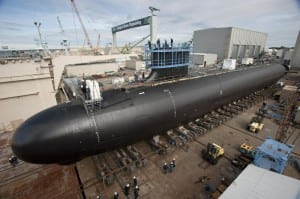A Navy official said Australian payments to help the U.S. submarine industrial base (SIB) under the AUKUS agreement will largely be directed to increase attack submarine (SSN) production above current plans, with the goal to make up for attack sales to Australia.
“AUKUS is an opportunity, a wonderful opportunity from a strategic and tactical perspective for our submarine force. We can get to one plus 2.33, we can get partner help as we drive toward an improved manufacturing technology industrial base, a new industrial base,” Matthew Sermon, executive director of the Program Executive Office for Strategic Submarines, said during the annual Naval Submarine League.

Sermon’s position covers leadership of the Columbia-class ballistic missile (SSBN) acquisition program, the in-service Ohio-class SSBNs/SSGNs and he is also tasked with revitalizing the overall SIB.
The AUKUS agreement plans to have the U.S. and U.K. help Australia field nuclear-powered SSNs, starting with three to five used and new Virginia-class submarines sold in the 2030s. Ultimately, Australia plans to domestically build the new SSN-AUKUS design, with the first new submarine delivered in the early 2040s. The U.K. will field the same design and plans to field its first SSN-AUKUS in the late 2030s.
The Navy is pushing additional investment and more consistent procurement with Congress to have the U.S. SIB eventually reach the current demand rate of one Columbia-class SSBN per year and two Virginia-class attack submarines per year. This is called one plus two per year, with the focus on Columbia-class submarines as the highest priority as part of the military’s nuclear deterrent force.
However, Navy officials are also looking at pushing production up past that to one plus 2.33 Virginia-class boats per year, to make up for the Australian sales.
A Congressional Budget Office (CBO) report published last week confirmed the government estimates Australia will support the U.S. industrial base with about $3 billion, split into $2 billion in 2025, and the remaining spread from 2026 to 2035 (Defense Daily, Nov. 3).
Following his remarks, Sermon told reporters that the Navy is aiming to largely spend the $3 billion Australia investment in the U.S. SIB to increase U.S. domestic submarine production above the two Virginia-class per year rate it is pursuing.
“The objective is to fold it in as the 2.33 part, really getting to that additional Virginia-class capacity,” he said.

However, another recent CBO report said while the Navy plans to build additional Virginia-class SSNs in the 2030s to replace the three to five sold submarines, it determined the Navy would need to build 1.9 to 2.6 SSNs per year, depending on which of the three alternatives in the latest 30-year shipbuilding plan is followed.
CBO argued since the U.S. submarine industrial base “is currently struggling to meet the Navy’s demand for submarines” while industry is building under 1.5 SSNs per year in addition to the ongoing SSBN work, it takes a dim view of the Navy’s ability to build more than two SSNs per year in addition to SSBNs.
The report said “it would be very difficult and expensive for the U.S submarine industry to increase production of attack submarines during a period when it must also build one Columbia-class ship per year,” so it viewed SSN sales to Australia as more likely reducing the total number of attack submarines available to the U.S. Navy for 20 years (Defense Daily, Oct. 30).
The two American submarine shipyards are General Dynamics’ [GD] Electric Boat and HII’s [HII] Newport News Shipyard.
Sermon said the $3 billion in Australia SIB funding will be split across several lines of effort with the industrial base. Some of the funds, particularly those directed to boost the workforce, could help the U.S. reach the base amount of two attack submarines produced per year rather than purely boost production beyond that.
“Across six different buckets of effort – that’s not a perfect science. It is additive to the investment that the Navy is doing,” he told reporters.
Sermon was overall optimistic that the Navy’s plans will come to fruition, arguing that by 2028 the Navy will achieve the one SSBN plus two SSN build rate.
During his remarks, Sermon said by then the future USS District of Columbia (SSBN-826) will have been delivered, the follow-on boat future USS Wisconsin (SSBN-8276) will be “really close behind,” the third and fourth new SSBNs will be under construction and advanced construction for the fifth boat will be underway too.